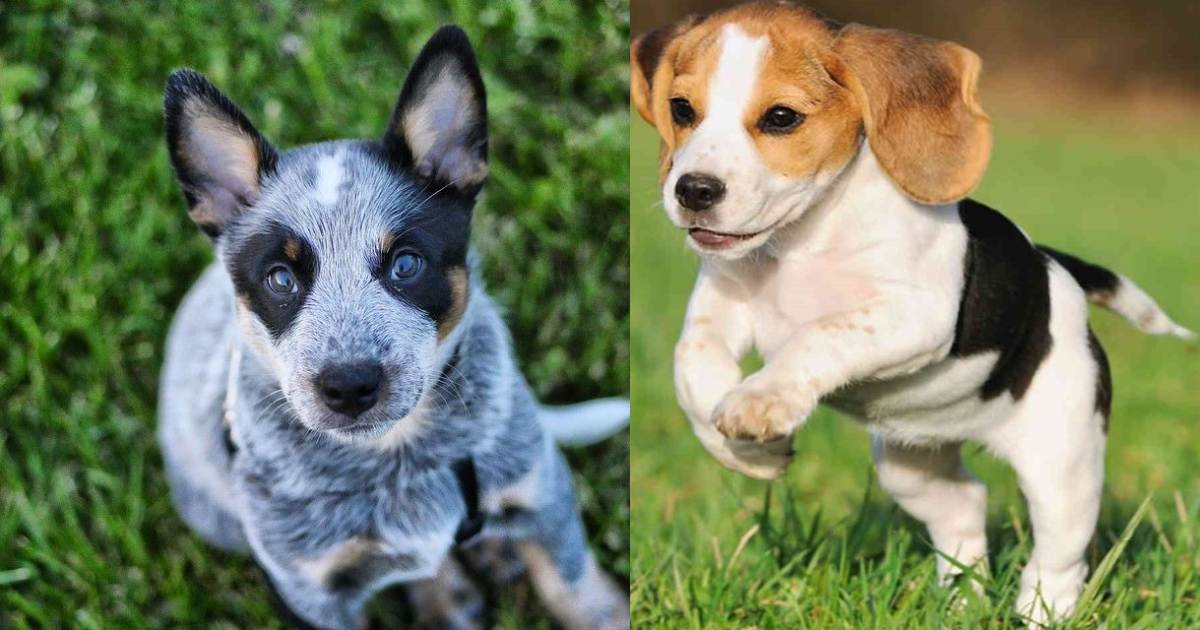The Beagle Blue Heeler mix is a cross between a Beagle and an Australian Cattle Dog, known commonly as a Blue Heeler. This blend results in a small to medium sized dog that is energetic, loyal, and loving towards its family. They need regular exercise and stimulation to keep their minds and bodies active.
Beagle Blue Heeler Mix: The Perfect Blend Of Playfulness And Loyalty. This unique mix combines the fun-loving nature and playfulness of the Beagle with the hardworking drive and loyalty of the Blue Heeler. Owners are guaranteed to have an active companion always ready for adventures.
A Beagle Blue Heeler has a coat that can be short or medium in length and come in various colors including brown, white, black or mottled. They are easily trained and eager to please their owners. Due to their herding background, they enjoy activities that engage their mind like obedience training or agility. Their boundless energy makes them a fantastic choice for owners with an active lifestyle.
Beagle: Characteristics and Behavior
The beagle’s soulful eyes and silly smiles have captivated people for centuries with their fun-loving charm. Underneath their long floppy ears and wagging tails, beagles hide inquisitive minds that love to learn, play and please. Whether sniffing out squirrels in the park or curling up for cuddles at home, beagles bring boundless energy and affection to every home they join.
Traits and Characteristics of Purebred Beagles
Purebred beagles are small hounds. They have short fur that is white, brown and black. Beagles have long floppy ears and curled tails. There are two types – pocket beagles are tiny and regular beagles are a bit bigger. Beagles have strong bodies well suited for hunting rabbits and hares. Their noses are very powerful for scent tracking.
Common Behaviors and Temperament Seen in Beagles
Beagles are typically friendly, gentle dogs. They get along with children and other pets. Beagles are playful, energetic and love to chase toys. They enjoy long walks and playtime to burn energy. Beagles can be stubborn at times but are eager to please their owners. With early socialization, beagles become comfortable around strangers and new environments.
Training Needs Specific to Beagles
Beagles are intelligent dogs that learn quickly from positive reinforcement training. Start sessions young before behaviors set in. Be consistent with commands like sit, stay, come and heel. Reward beagles with treats and praise during lessons. Repeated training keeps them well-behaved. Being quiet and avoiding harsh tones helps beagles stay focused.
Health Issues Commonly Associated with Beagles
Some potential health problems beagles may face include hip and elbow dysplasia, eye diseases and allergies. Beagles are also prone to weight gain so their diet must be monitored. Regular vet checkups allows catching any issues early. With proper care, beagles have an average lifespan of 15 years and stay actively playful for most of their life.
Blue Heelers/Australian Cattle Dogs: History and Traits

Blue Heelers, also called Australian Cattle Dogs, come from Australia. Farmers needed a small dog to help herd cattle. Blue Heelers proved very good at this job. They nip heels to keep cows together. Blue Heelers are smart, brave and fast. These traits make them excellent workers.
Blue Heelers can have different coat colors like blue or red. They have short fur and standing up ears. Blue Heelers show strong loyalty to their owners. They also stay alert and watchful. It is important for Blue Heelers to get exercise every day. Long walks, plays or runs help use their energy. Without work, Blue Heelers may feel bored and restless. Positive training teaches Blue Heelers to behave well. With activities and rules, they become happy companions.
Introduction to Blue Heelers, also known as Australian Cattle Dogs
The Blue Heeler is a clever herding dog from farms in Australia. These dogs are also called Australian Cattle Dogs and were trained to help with cattle. Blue Heelers are smart, fast and brave working companions.
Overview of the breed’s history and working abilities
Blue Heelers were bred by cattle farmers in Australia many years ago. They use their intelligence and speed to help herd cows and keep them close together. By nipping at cow’s heels, Blue Heelers move the large animals without hurting them. Their bravery and skills made them perfect cattle dogs for Australian ranches.
Key traits and characteristics of Blue Heelers
Blue Heelers come in several colors like blue or red fur. They have short coats and erect ears that stand up from their head. These herding dogs are always loyal to their human owners and families. Blue Heelers remain alert and watchful due to their work on farms.
Exercise requirements for Blue Heelers
Blue Heelers need a lot of activity like walks, plays, and runs every day. They have high energy from their jobs herding cattle on ranches. Without exercises, these dogs can feel bored and restless in the home. Long play sessions help Blue Heelers stay strong and happy companions.
Effective training methods for Blue Heelers
Blue Heelers are smart dogs that learn quickly from their owners. Using rewards like treats or praise works well for teaching Blue Heelers commands. It is best to begin training when they are puppies and be consistent with lessons. Patient instruction will help these dogs behave properly in homes.
Understanding Mixed Breeds/Mutts
Many dogs are mixed breeds. This means they have parent dogs of two different kinds. We call these mixes “mutts”. Mutts can have all sorts of looks because their parents weren’t the same breed. Sometimes it’s hard to know what traits a mutt will have.
Mutts need homes just like purebred dogs. Loving families can give mutts wonderful lives. Their parents may be big or small dogs so mutts can end up many sizes too. Mutts stay healthy due to genetic variety from their parents. With care and training, mutts learn and play nicely just like any other dog. They make devoted companions whether in big cities or farms. Mutts bring joy wherever they are.
Advantages and Disadvantages of Owning Mixed Breed Dogs
Mutts have benefits of two breeds which can make them healthier and more adaptable. Their traits are surprises since parents are not the same breed. The love of mutts is no less than purebreds even if their looks cannot be planned. With care and time, the pros of mutts’ personalities outweigh any unknown cons.
Traits Inherited by Beagle Blue Heeler Mix from Parent Breeds
A Beagle Blue Heeler mix may get senses of smell from Beagle parents. They could also get herding skills from Blue Heeler mom and dad dogs. The mix may act smart and alert like Blue Heelers or friendly like Beagles. Owners must ensure this pup stays active with traits from both hardworking breeds.
Common Health Concerns and Temperament Issues in Mixed Breeds
Since mutts combine two breeds, their traits are surprises. Sometimes health problems from parent breeds can happen to mixes too. With love and training from a young age, temperament issues are unusual. Taking puppies to vet checkups ensures their long, happy lives with owners.
Size and Appearance of Beagle Blue Heeler Mix

A Beagle Blue Heeler mix is a smaller dog weighing 20 to 30 pounds. His fur can be short and come in colors of blue, red or tan. Owners never know exactly how the pup will look since beagles and blue heelers look different. All pups are unique.
This mix inherits traits from both parents. He may have a short tail like a Blue Heeler or long floppy ears like a Beagle. His face can take on features from mom or dad too. Some pups may have one parent’s coat and the other’s color. No matter the look, all Beagle Blue Heeler mixes find loving homes. Their personalities charm families with smiles and wagging tails.
Average height and weight of Beagle Blue Heeler mix
Most Beagle Blue Heeler mixes are medium sized dogs. Their height is between 15 to 20 inches from paw to shoulder. Beagle Blue Heeler pups usually weigh between 20 to 30 pounds. Their size makes them playful pets for homes with kids.
Overview of coat colors and physical features in this mix
Beagle Blue Heeler mixes can have coats that are tan, red or blue. Their fur can be short like a Blue Heeler or medium length. These pups may get floppy ears from Beagles or up ears from Heelers. Body shapes vary but most are medium in size from their parent breeds.
Temperament and Behavior of Beagle Blue Heeler Mix
The Beagle Blue Heeler mix combines the happy-go-lucky Beagle with the energetic and clever Blue Heeler. This makes for a fun-loving dog with a big personality. They’re incredibly loyal and love spending time with their families, showering them with kisses and playful jumps. Like the Beagle, they’re friendly with everyone, making them great playmates for children and other pets.
Their Blue Heeler side gives them a strong work ethic and intelligence. They love challenges and games, so playtime is never dull with a Beagle Blue Heeler. All that energy needs an outlet. Daily walks, playtime in the park, and even learning tricks will keep them happy and well-behaved. With all their love and enthusiasm, this mixed breed promises a lifetime of adventures and furry friendship.
Personality traits commonly found in this hybrid breed (compared to parent breeds)
Beagle Blue Heelers are super friendly, just like Beagles. They love everyone they meet, making them great playmates for you and your friends. They’re also curious and love to explore, like Blue Heelers. This means they need lots of walks and playtime to sniff out all the exciting smells Beagle Blue Heelers are smart cookies, just like their Blue Heeler parents.
They learn tricks quickly and love a good challenge, so keep them busy with games and puzzles. But remember, all that energy needs an outlet. Make sure your Beagle Blue Heeler gets plenty of exercise to stay happy and well-behaved.
Training and Exercise Needs of Beagle Blue Heeler Mix

Your Beagle Blue Heeler mix is a bundle of playful energy and smarts, just like their Beagle and Blue Heeler parents. To keep them happy and well-behaved, they need both training and plenty of exercise. Here’s how to help your furry friend thrive:
Training:
- Start early! Puppies are eager to learn, so basic commands like sit, stay, and come can be taught from a young age.
- Be patient and positive. Use treats and praise to reward good behavior, and gently redirect them if they make mistakes. Remember, learning takes time!
- Short, engaging training sessions with plenty of playtime in between will keep your dog motivated and interested.
Exercise:
- Think zoomies, Beagle Blue Heelers have tons of energy and need at least 60 minutes of exercise daily. This could be walks, jogs, hikes, or playtime in the park.
- Mental stimulation is key too! Puzzle toys, agility courses, and even learning new tricks will tire their minds and prevent boredom.
- A tired dog is a happy dog, By meeting their exercise and training needs, you’ll ensure your Beagle Blue Heeler lives a healthy and fulfilling life.
With a little effort and understanding, you can create a strong bond with your Beagle Blue Heeler and have tons of fun along the way! Remember, they’re your furry companion for life, so invest in their training and exercise for a happy and healthy pup.
Best training techniques for this hybrid breed
- Positive Reinforcement: Reward good behavior with treats, praise, and petting. This will make them want to repeat the desired behavior.
- Short & Engaging Sessions: Keep training sessions short and fun, around 5-10 minutes at a time. This will help them stay focused and motivated.
- Consistency is Key: Be consistent with your commands and expectations. Use the same words and cues every time, and be patient if they don’t get it right away.
- Channel their Energy: Provide plenty of exercise and mental stimulation to tire them out and prevent boredom, which can lead to destructive behavior.
- Early Socialization: Start socializing your Beagle Blue Heeler puppy early with other dogs, people, and animals. This will help them grow into well-adjusted and friendly companions.
- Make it Fun: Use toys, games, and positive reinforcement to make training fun and engaging for both you and your pup. This will create a strong bond and make the process more enjoyable for everyone.
- Professional Help: If you’re having trouble training your Beagle Blue Heeler, don’t hesitate to seek help from a professional dog trainer. They can provide personalized guidance and support to help you achieve your training goals.
Mental stimulation exercises to keep them engaged
Keep those smart minds buzzing with fun mental challenges! Puzzle feeders stuffed with treats become exciting treasure hunts, while hiding toys around the house turns your pup into a detective.
Physical activities recommended for Beagle Blue Heeler mix
Beagle Blue Heelers are energetic bundles of joy, inheriting both the Beagle’s love for sniffing adventures and the Blue Heeler’s herding instincts. To keep them happy and healthy, physical activities are key, Daily walks are a must, but consider amping it up with:
- Hiking: Let their noses explore new scents and their bodies conquer trails, like adventurous explorers.
- Agility Training: Channel their herding instincts with obstacle courses and tunnels, unleashing their inner athlete.
- Games of Fetch: A classic favorite, Satisfy their love for chasing and bring out their playful side.
Health Concerns for Beagle Blue Heeler Mix
While your Beagle Blue Heeler mix is likely a vibrant and active pup, like any hybrid breed, they inherit potential health concerns from their parent breeds. Here’s a heads-up on some things to be aware of:
- Hip Dysplasia: Common in both Beagles and Blue Heelers, this malformation of the hip joint can cause pain, lameness, and arthritis. Early detection and management with your vet are crucial.
- Eye Issues: Both breeds are prone to eye problems like progressive retinal atrophy (PRA) and cataracts, leading to vision loss. Regular eye exams by your vet are essential for monitoring their vision.
- Epilepsy: Beagles have a higher risk of epilepsy, which can cause seizures. If you notice any unusual behavior or twitching, consult your vet immediately.
- Allergies: Beagles are prone to skin allergies triggered by pollen, food, and even fleas. Identifying the allergen and proper management with your vet can bring relief.
- Deafness: Blue Heelers can inherit deafness, especially in merle-coated pups. Early testing by your vet can confirm hearing abilities and guide you in training approaches.
Common health issues associated with this hybrid breed
Your energetic Beagle Blue Heeler may be a playful pup, but like any mixed breed, they inherit potential health concerns. Keep watch for:
- Hip Dysplasia: Both parent breeds are prone to this painful joint malformation, so early detection and vet management are key.
- Eye Issues: Regular vet checkups can monitor for vision-threatening problems like cataracts and progressive retinal atrophy, common in Beagles and Blue Heelers.
Adoption and Breeder Information for Beagle Blue Heeler Mix

Looking for a playful, energetic pup who loves adventures? The Beagle Blue Heeler mix might be your perfect match. No matter which path you choose, remember to welcome your Beagle Blue Heeler mix with open arms and lots of love.
Be prepared for an active, curious pup who needs plenty of exercise and mental stimulation. With dedication and understanding, you and your furry friend will embark on countless adventures and build a lifelong bond. Before welcoming one into your family, here are some helpful tips:
Adoption:
- Rescue the love: Many shelters and rescue organizations have adorable Beagle Blue Heelers looking for loving homes. These pups deserve a second chance, and adoption is a rewarding way to find your forever friend.
- Meet and greet: Spend time with different pups to see who clicks with you. Ask shelter staff about their personalities and energy levels to find the perfect fit.
Breeders:
- Do your research: Choose responsible breeders who prioritize health, temperament, and ethical breeding practices. Ask about health clearances for parent dogs and meet the puppies in person.
- Be patient: Waiting for the right puppy can take time, but it’s worth it to ensure you find a healthy and happy companion for life.
Finding Reputable Breeders Specializing in This Hybrid Breed
While the Beagle Blue Heeler mix is a charming hybrid, finding a responsible breeder can be tricky. Here’s how to spot the good guys:
- Do your research: Look for breeders affiliated with reputable kennel clubs or organizations specific to mixed breeds.
- Ask questions: Inquire about parent dogs’ health clearances, puppy socialization, and breeding practices. Transparency is key.
- Visit in person: Observe the living conditions of pups and parents. A clean, loving environment is a good sign.
FAQ’s
What is the personality of a Blue Heeler Beagle mix?
A Blue Heeler Beagle mix combines Beagle’s playful curiosity with Blue Heeler’s intelligence and loyalty, creating a fun-loving, energetic pup.
Is a Blue Heeler a loyal dog?
Yes, Blue Heelers are fiercely loyal and devoted companions, known for their unwavering love and protectiveness towards their families.
What is the temperament of a Blue Heeler mix?
Expect a playful, energetic, and loyal pup with a Beagle’s love for fun and a Blue Heeler’s herding instincts.
What is the temperament of a Beagle mix?
A Beagle mix inherits the Beagles’ playful, curious, and friendly nature, often with a bonus boost of energy and trainability from the other breed in the mix.
Is Beagle a loyal dog?
Beagles are notorious for their charmingly stubborn streak and keen noses, but deep down, they’re incredibly loyal companions.
Conclusion
The Beagle Blue Heeler mix is a delightful combination of two amazing dog breeds. From the Beagle’s infectious enthusiasm and endless love of sniffing adventures to the Blue Heeler’s intelligence, loyalty, and zest for life, this hybrid pup promises a life full of fun and furry friendship.
Imagine a playful Beagle puppy bouncing with excitement, combined with the focused determination of a Blue Heeler herding cattle. That’s the kind of energy you can expect from this mixed breed! They’ll be your partners in backyard romps, enthusiastic explorers on nature walks, and cuddly companions on movie nights. Their loyalty shines through in everything they do, showering you with affection and always being by your side.
Whether you’re an active family looking for an adventurous playmate or a laid-back soul seeking a cuddly companion, the Beagle Blue Heeler mix might just be your perfect match. Just remember, these energetic pups need plenty of exercise, mental stimulation, and love to thrive. With dedication and understanding, you’ll create a lifelong bond with this playful, loyal, and endlessly entertaining furry friend. So, open your heart and home to a Beagle Blue Heeler mix, and get ready for a lifetime of tail wags, happy barks, and endless adventures.







